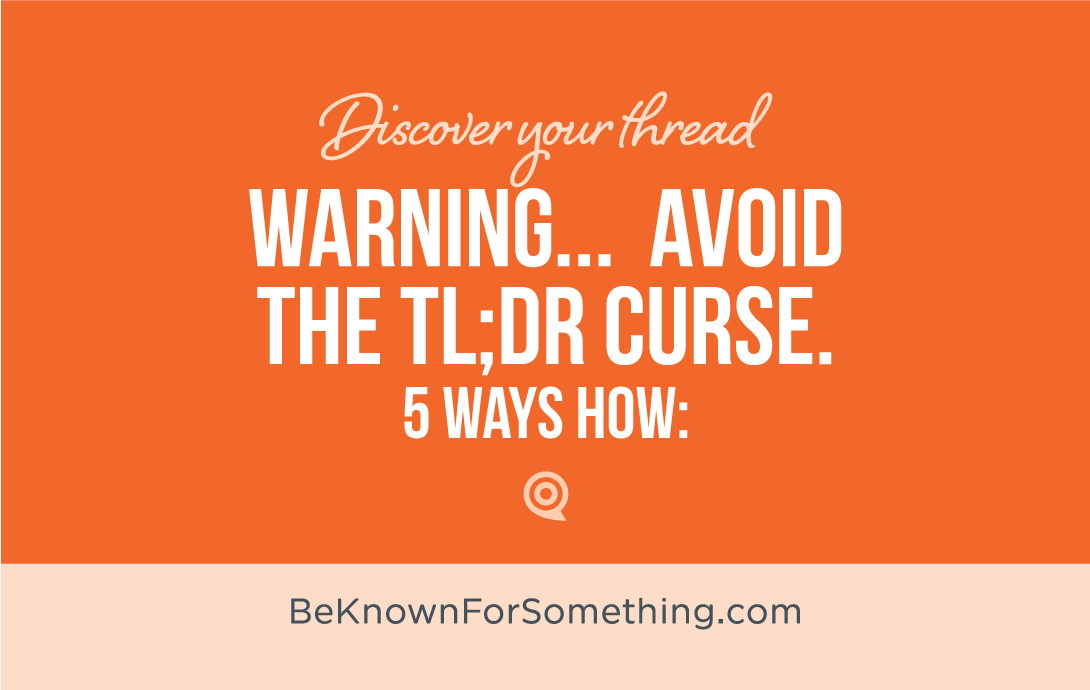WARNING. Avoid the TL;DR Curse. 5 Ways How:

Social media has changed us. Or maybe it’s just exposed things we’ve kept secretive (but thought of regularly). On social media, we love to use fun acronyms or abbreviations to state the obvious for the masses. If something is humorous, we use LOL (laugh out loud). Or if someone oversteps or meddles, we use MYOB (mind your own business). Want to remind someone of info they may have missed in the noisy past? Use ICYMI (in case you missed it).
I could list dozens of these. We’ve obviously thought them regularly, so people started to quickly abbreviate them. It’s faster to post a few letters and have everyone quickly know the longer meaning.
Social media even has one that sums up this thought: TL;DR (too long; didn’t read). Why? Because EVERYTHING needs to be short or people won’t take the time to get the information. They won’t wade through long information — there’s just far too much content from so many sources. We just don’t have the time!
Church! Wake up. We often over-speak or over-write and people think “sorry, TL;DR” — and once that feeling hits them, it’s too late. We’ve blown it. They’ll never know the important thing we should tell them. This isn’t just social media content either — it’s content during a sermon, in a handout, on a web page, announcements, and even in emails.
It’s a curse. A curse that we can overcome. Here are 5 things you MUST do so that you don’t get cursed with TL;DR:
- Use descriptive, leading headlines and subheads. Make sure that the headline genuinely states the purpose and benefit of the content that follows. Most will stop after they skim the headline though.
- Eliminate all unnecessary words, phrases, concepts. Want them to read past the headline? The content needs to “feel” short. They want you to do the editing and tell them the most important things (since you’re the subject matter expert). More time should be spent editing than in creating the content.
- Summarize your whole thought quickly in a short initial paragraph. That first, short paragraph can blow it. It should say “this is interesting” or it’ll say “TL;DR”.
- Use bullet points to provide a skeleton. Sure, most will skip that first paragraph and jump to the bullet points. If they’re there. Make sure they are! Make them short and beneficial. Make them the basic skeleton that the entire content is hung on. It’s what I’ve done with this article.
- Add eye-interruptors to suggest understanding. Want the feeling of “short” when it’s not? Make sure there are certain things within your content that eyes will catch on (links, bold points, etc.). Things that will fill in the blanks about the entire content. You want people to stumble upon content that says their demographic, their pains, concerns, and goals.
Want 25 Game-Changing Resolutions?
Related Posts

3 Church Leadership Skills That Transform Your Ministry
You didn’t accept a call to ministry just to maintain the status quo. You were called to lead to inspire,

How to Create a Church Marketing Strategy That Reaches Your Community
You’ve been called to lead a church that makes a difference in your city. That means developing a clear church

Top 10 Church Digital Marketing Strategies for 2026
What’s Changing, What’s Working, and What’s Next 2026 will be a year of rapid change for church digital marketing strategies

